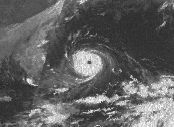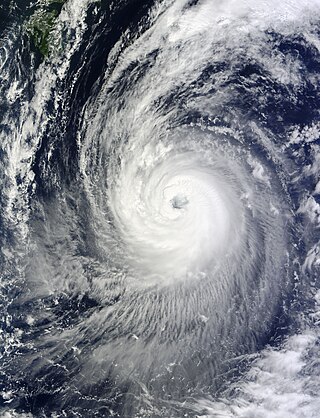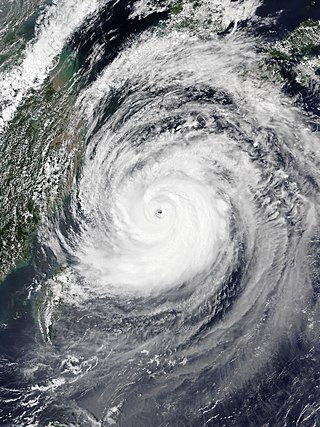
Typhoon Nabi, known in the Philippines as Super Typhoon Jolina, was a powerful typhoon that struck southwestern Japan in September 2005. The 14th named storm of the 2005 Pacific typhoon season, Nabi formed on August 29 to the east of the Northern Mariana Islands. It moved westward and passed about 55 km (34 mi) north of Saipan on August 31 as an intensifying typhoon. On the next day, the Joint Typhoon Warning Center upgraded the storm to super typhoon status, with winds equivalent to that of a Category 5 hurricane on the Saffir–Simpson Hurricane Scale. The Japan Meteorological Agency estimated peak ten-minute winds of 175 km/h (109 mph) on September 2. Nabi weakened while curving to the north, striking the Japanese island of Kyushu on September 6. After brushing South Korea, the storm turned to the northeast, passing over Hokkaido before becoming extratropical on September 8, before dissipating on September 12.

The 2018 Pacific typhoon season was at the time, the costliest Pacific typhoon season on record, until the record was beaten by the following year. The season was well above-average, producing twenty-nine storms, thirteen typhoons, seven super typhoons and six Category 5 tropical cyclones. The season ran throughout 2018, though most tropical cyclones typically develop between May and October. The season's first named storm, Bolaven, developed on January 3, while the season's last named storm, Man-yi, dissipated on November 28. The season's first typhoon, Jelawat, reached typhoon status on March 29, and became the first super typhoon of the year on the next day.

Typhoon Bart, known in the Philippines as Typhoon Oniang, was a powerful and destructive typhoon that occurred during the 1999 Pacific typhoon season. It was the only super typhoon of that year. Bart reached "super typhoon" status on September 22, when it grew to comprise winds containing a force of 260 km/h (160 mph).

Typhoon Ida, also known as the Kanogawa Typhoon, was the sixth-deadliest typhoon to hit Japan, as well as one of the strongest tropical cyclones on record. On September 20, Ida formed in the Western Pacific near Guam. It moved to the west and rapidly intensified into a 185 km/h (115 mph) typhoon by the next day. On September 22, Ida turned to the north and continued its quick rate of intensification. Two days later, the Hurricane Hunters observed a minimum barometric pressure of 877 mb (25.9 inHg), as well as estimated peak winds of 325 km/h (202 mph). This made Ida the strongest tropical cyclone on record at the time, although it was surpassed by Typhoon June 17 years later. Ida weakened as it continued to the north-northeast, and made landfall in Japan on southeastern Honshū with winds of 130 km/h (80 mph) on September 26. It became extratropical the next day, and dissipated on the September 28 to the east of the country. Ida caused torrential flooding to southeastern Japan, resulting in over 1,900 mudslides. Damage was estimated at $50 million, and there were 1,269 fatalities.

Typhoon Cora, also known as the 2nd Miyako-jima Typhoon in Japan, was a typhoon that hit the Ryūkyū Islands in 1966.

Typhoon Abby, known in the Philippines as Typhoon Diding, was an extremely powerful tropical cyclone which was the second typhoon to strike Japan within a span of a few days in August 1983. First noted southeast of Guam on July 31, development of this system was initially slow to occur; it was first classified on August 5, and was upgraded into a tropical storm the next day. Intensification was rapid as Abby slowly recurved northward on August 7 and 8. After reaching peak intensity with winds of 140 mph (225 km/h) early on August 9, Abby slowly weakened, though the storm briefly re-intensified on August 11. By August 14, winds had diminished to 100 mph (160 km/h). Abby finally weakened back into a tropical storm on August 17 not long after making landfall in Japan. The following day, Abby completed the transition to an extratropical cyclone after moving through central Japan. However, meteorologists continued monitoring the storm for six more days.

Typhoon Ma-on, known in the Philippines as Typhoon Rolly, was a powerful typhoon that produced record breaking wind gusts across the Tokyo Metropolitan Area during October 2004. The twenty-second named storm of the 2004 Pacific typhoon season, Ma-on was the second of three consecutive storms to hit Japan during the period between late-September to mid-October 2004.

Typhoon Phanfone, known in the Philippines as Typhoon Neneng, was a powerful tropical cyclone which affected Japan in early October 2014. It was the eighteenth named storm and the eighth typhoon of the 2014 Pacific typhoon season. Phanfone started as a large area of convection well west of the International Date Line. The system was well organized and classified as Tropical Depression 18W on September 29. At the same day, it gained the name Phanfone due to very favorable conditions and intense thunderstorms rich with convection surrounding the storm's center. Phanfone would later go rapid intensification on October 1 due to warm sea-surface temperatures and very favorable environments. JTWC upgraded Phanfone to a Category 4 typhoon but weakened later back to Category 3 due to its eye replacing the old one and undergoing a minor eyewall replacement cycle.

Typhoon Vongfong, known in the Philippines as Super Typhoon Ompong, was the most intense tropical cyclone worldwide in 2014, and struck Japan as a large tropical system. It also indirectly affected the Philippines and Taiwan. Vongfong was the nineteenth named storm and the ninth typhoon of the 2014 Pacific typhoon season. Estimates assess damage from Vongfong to have been over US$160 million, mainly for striking mainland Japan. At least 9 people were killed along the path of the typhoon in those countries.

Typhoon Kent was a strong mid-season typhoon that struck southern Japan during August 1992. An area of convection developed east of the International Date Line. Tracking west-northwestward, a tropical depression developed on August 5, and the next day, intensified into a tropical storm. On August 8, increased vertical wind shear caused convection to decrease, although Kent strengthened into a typhoon on the next day. An eye then appeared as conditions aloft became more conducive, and on August 11, Kent attained its peak intensity. Under the influence of a subtropical ridge located to its north, the typhoon initially continued to move west-northwestward before turning towards Kyushu. The storm steadily weakened prior to making landfall on August 18 just below typhoon intensity. The mountainous terrain of Japan accelerated the weakening trend, and on August 20, Kent dissipated.

Typhoon Lan, known in the Philippines as Super Typhoon Paolo, was the third-most intense tropical cyclone worldwide in 2017, behind only hurricanes Irma and Maria in the Atlantic. A very large storm, Lan was the twenty-first tropical storm and ninth typhoon of the annual typhoon season. It originated from a tropical disturbance that the United States Naval Research Laboratory had begun tracking near Chuuk on October 11. Slowly consolidating, it developed into a tropical storm on October 15, and intensified into a typhoon on October 17. It expanded in size and turned northward on October 18, although the typhoon struggled to intensify for two days. On October 20, Lan grew into a very large typhoon and rapidly intensified, due to favorable conditions, with a large well-defined eye, reaching peak intensity as a "super typhoon" with 1-minute sustained winds of 249 km/h (155 mph) – a high-end Category 4-equivalent storm – late on the same day. Afterward, encroaching dry air and shear caused the cyclone to begin weakening and turn extratropical, before it struck Japan on October 23 as a weaker typhoon. Later that day, it became fully extratropical before it was absorbed by a larger storm shortly afterward.

Typhoon Jebi, known in the Philippines as Super Typhoon Maymay, was the costliest typhoon in Japan's history in terms of insured losses. Jebi formed from a tropical disturbance south-southwest of Wake Island on August 26 and became the twenty-first named storm of the 2018 Pacific typhoon season on August 27. Amid favorable environmental conditions, Jebi quickly strengthened into a typhoon on August 29 as it headed west and rapidly intensified as it passed the Northern Mariana Islands on August 30. Jebi reached its peak intensity as a Category 5-equivalent typhoon on August 31, with 10-minute sustained winds of 195 km/h (120 mph), 1-minute sustained winds of 285 km/h (180 mph), and a minimum pressure of 915 hPa. Afterwards, Jebi began a slow weakening trend as it turned northwest, briefly passing through the Philippine Area of Responsibility on September 2. Jebi accelerated north-northeast towards Japan on September 3 as it interacted with the westerlies, and made landfalls over Shikoku and near Kobe early on September 4. Jebi quickly weakened over land and became an extratropical cyclone later that day over the Sea of Japan. Its remnants moved over the Russian Far East before dissipating on September 9.

Typhoon Faxai, known in Japan as Reiwa 1 Bōsō Peninsula Typhoon, was the first typhoon to strike the Kantō region since Mindulle in 2016, and the strongest typhoon to hit the region since Ma-on in 2004. It was also the worst to hit the region since Talas in 2011, until the region was hit by more destructive Typhoon Hagibis less than a month later. Forming as the fifteenth named storm of the 2019 Pacific typhoon season, the precursor to Faxai was first noted as a weak tropical depression to the east of the International Dateline on August 29. The depression then entered the West Pacific basin on August 30. After moving in a general westward direction, the system strengthened into a named tropical storm by September 5. Faxai then strengthened into the sixth typhoon of the season the next day. Two days later, Faxai reached its peak strength as a Category 4 typhoon just before making landfall in mainland Japan. Turning northeastward, Faxai rapidly weakened and became extratropical on September 10.

Typhoon Maysak, known in the Philippines as Typhoon Julian, was a deadly, damaging and powerful tropical cyclone that struck the Ryukyu Islands and the Korean Peninsula in September 2020. The third typhoon of the 2020 Pacific typhoon season, Maysak formed from a tropical disturbance. The disturbance gradually organized, receiving the name Julian from PAGASA as it became a tropical depression. As the depression strengthened, the JMA subsequently named the system Maysak. Maysak rapidly intensified into a strong typhoon before weakening and making landfall in South Korea.

Typhoon Prapiroon, known in the Philippines as Severe Tropical Storm Florita, was a Category 1 typhoon that worsened the floods in Japan and also caused impacts in neighboring South Korea. The storm formed from an area of low pressure near the Philippines and strengthened to a typhoon before entering the Sea of Japan. The seventh named storm and the first typhoon of the annual annual typhoon season. Prapiroon originated from a low-pressure area far off the coast of Northern Luzon on June 28. Tracking westwards, it rapidly upgraded into a tropical storm, receiving the name Prapiroon due to favorable conditions in the Philippine Sea on the next day.

Typhoon Dinah was a tropical cyclone that brought heavy damages to Japan, while leaving 65 fatalities and 70 to be missing, all in that country alone. It is also one of the disasters that happened in the country during the Showa 27 era. The second typhoon of the 1952 Pacific typhoon season, Dinah was first mentioned in weather maps as a tropical depression to the east of Visayas. It gradually organized, becoming a tropical storm on June 21 as it skirted the northeastern Philippines, with the Fleet Weather Center naming it Dinah. It strengthened further to a minimal typhoon as it moved through the Nansei Islands on June 22, before reaching its peak intensity of 140 km/h, as estimated by the Fleet Center. It then weakened shortly, before passing near Shikoku on the next day, then making landfall through the southern part of the Kii Peninsula before gradually weakened further and started to undergo extratropical transition as it moved out of the country on June 24. It then became fully extratropical on the next day.

Severe Tropical Storm Maliksi, known in the Philippines as Severe Tropical Storm Domeng, was a tropical cyclone in June 2018 that brought rainfall to the Philippines and Japan. It caused 2 deaths and prompted the PAGASA to declare the beginning of the rainy season in the Philippines. The fifth named storm and 4th tropical cyclone in the Philippine Area of Responsibility (PAR), it was first noted as an area of convection in the South of Palau on May 31.

Typhoon Louise, known in Japan as the Akune Typhoon, was a deadly and destructive tropical cyclone that hit Japan in October 1945, soon after the cessation of World War II. It caused at least 377 deaths and another 74 missing persons, while leaving a wide swath of damage across the country.

Typhoon Ione was a catastrophic and deadly tropical cyclone that left over 512 confirmed deaths and another 326 to be missing as it affected Japan, with the majority of the fatalities coming from the city of Ichinoseki in Iwate Prefecture. It also left a significant trail of damage on the country, just after Typhoon Kathleen devastated the area. The fourteenth named storm and the ninth typhoon of the 1948 Pacific typhoon season, Ione was first seen in weather maps as a tropical storm near the Mariana Islands on September 11. It moved to the northwest, passing through the island country, before strengthening to a typhoon on September 13. It rapidly organized to a Category 4 typhoon and reached its peak intensity on the next day before slowly weakening as it started to approach the Japanese archipelago, while curving to the northeast. It then made landfall on September 16 between the present cities of Tateyama and Kisarazu in Chiba Prefecture as a minimal typhoon. It then passed through the southern coast of Hokkaido, before gradually degraded to a tropical storm as it emerged in the Pacific Ocean on the next day. It then became extratropical, shortly after.

Typhoon Gilda, known in the Philippines as Typhoon Deling was a destructive, deadly, costly and long-lived tropical cyclone that left over 145 confirmed deaths over Japan and South Korea, mostly due to torrential rainfall that induced landslides, all generated by the typhoon and its associated meiyu front. The eighth named storm and third typhoon of the 1974 Pacific typhoon season, the system was first noted by the China Meteorological Agency as an area of convection embedded on a trough, to the north of Enewetak Atoll on June 25. It was named Gilda on June 30 as it strengthened to a tropical storm. Under a favorable environment, it strengthened to a typhoon two days later as it moved northwestward. Another trough pulled Gilda poleward while changing less in intensity, until it intensified to a Category 2 typhoon as it battered the Ryukyu Islands at its peak. Increasing wind shear gradually weakened the system; however, it remained as a minimal typhoon until it passed through the southern tip of South Korea on July 6, where it weakened to a tropical storm. Colder waters in the Sea of Japan and high shear further degraded Gilda, until it transitioned to an extratropical low as it made landfall near Hokkaido on July 9. The remnants of the system briefly intensified near the Kuril Islands before weakening and dissipating on July 17 over the Sea of Okhotsk.
























